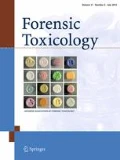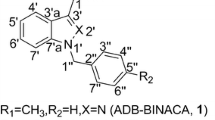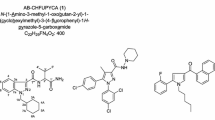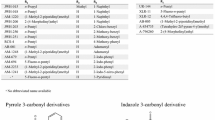Abstract
Six cannabimimetic indoles have been identified as adulterants in herbal or chemical products being sold illegally in Japan, with four of the compounds being new as adulterants to our knowledge. The identifications were based on analyses using gas chromatography–mass spectrometry, liquid chromatography–mass spectrometry, high-resolution mass spectrometry, and nuclear magnetic resonance spectroscopy. The first two compounds were identified as phenylacetyl indoles JWH-251 (2-(2-methylphenyl)-1-(1-pentyl-1H-indol-3-yl)ethanone; 1) and its demethyl-methoxylated analog JWH-250 (2-(2-methoxyphenyl)-1-(1-pentyl-1H-indol-3-yl)ethanone; 2). Compound 2 was identical to that found as an adulterant in the UK and in Germany in 2009. The third compound was naphthoylindole JWH-081 (1-(4-methoxynaphthalenyl)-(1-pentyl-1H-indol-3-yl)methanone; 3), and the fourth was JWH-073 (1-naphthalenyl(1-butyl-1H-indol-3-yl)methanone; 4), which had been identified as an adulterant in our previous study. Two additional compounds were JWH-015 (1-naphthalenyl(2-methyl-1-propyl-1H-indol-3-yl)methanone; 5) and JWH-200 (1-naphthalenyl(1-(2-(4-morpholinyl)ethyl)-1H-indol-3-yl)methanone; 6). Compounds 1–4 and 6 were reported to be synthetic cannabinoids with selective affinity for cannabinoid CB1 receptors, while compound 5 was reported to be a selective CB2 receptor agonist causing immunosuppressive effects without psychotropic affects. One product contained both CB1 and CB2 receptor agonists in our collection. Quantitative analyses of the six cannabimimetic compounds in 20 products revealed that there was large variation in concentrations of the detected compounds among products; for herbal cutting products, the total amounts of these cannabinoids ranged from 26 to 100 mg.








Similar content being viewed by others
References
Uchiyama N, Kikura-Hanajiri R, Kawahara N, Haishima Y, Goda Y (2009) Identification of a cannabinoid analog as a new type of designer drug in a herbal product. Chem Pharm Bull 57:439–441
Uchiyama N, Kikura-Hanajiri R, Kawahara N, Goda Y (2009) Identification of a cannabimimetic indole as a designer drug in a herbal product. Forensic Toxicol 27:61–66
Kikura-Hanajiri R, Kawamura M, Maruyama T, Kitajima M, Takayama H, Goda Y (2009) Simultaneous analysis of mitragynine, 7-hydroxymitragynine, and other alkaloids in the psychotropic plant “kratom” (Mitragyna speciosa) by LC-ESI-MS. Forensic Toxicol 27:67–74
Uchiyama N, Kikura-Hanajiri R, Ogata J, Goda Y (2010) Chemical analysis of synthetic cannabinoids as designer drugs in herbal products. Forensic Sci Int 198:31–38
Kikuchi H, Uchiyama N, Ogata J, Kikura-Hanajiri R, Goda Y (2010) Chemical constituents and DNA sequence analysis of a psychotropic herbal product. Forensic Toxicol 28:77–83
Auwärter V, Dresen S, Weinmann W, Müller M, Pütz M, Ferreirós N (2009) ‘Spice’ and other herbal blends: harmless incense or cannabinoid designer drugs? J Mass Spectrom 44:832–837
Lindigkeit R, Boehme A, Eiserloh I, Luebbecke M, Wiggermann M, Ernst L, Beuerle T (2009) Spice: a never ending story? Forensic Sci Int 191:58–63
Compton DR, Rice KC, De Costa BR, Razdan RK, Melvin LS, Johnson MR, Martin BR (1993) Cannabinoid structure–activity relationships: correlation of receptor binding and in vivo activities. J Pharmacol Exp Ther 265:218–226
Compton DR, Johnson MR, Melvin LS, Martin BR (1992) Pharmacological profile of a series of bicyclic cannabinoid analogs: classification as cannabimimetic agents. J Pharmacol Exp Ther 260:201–209
Melvin LS, Milne GM, Johnson MR, Subramaniam B, Wilken GH, Howlett AC (1993) Structure–activity relationships for cannabinoid receptor-binding and analgesic activity: studies of bicyclic cannabinoid analogs. Mol Pharmacol 44:1008–1015
Thomas BF, Compton DR, Martin BR (1990) Characterization of the lipophilicity of natural and synthetic analogs of delta 9-tetrahydrocannabinol and its relationship to pharmacological potency. J Pharmacol Exp Ther 255:624–630
Martin BR, Compton DR, Thomas BF, Prescott WR, Little PJ, Razdan RK, Johnson MR, Melvin LS, Mechoulam R, Ward SJ (1991) Behavioral, biochemical, and molecular modeling evaluations of cannabinoid analogs. Pharmacol Biochem Behav 40:471–478
Wiley JL, Compton DR, Dai D, Lainton JA, Phillips M, Huffman JW, Martin BR (1998) Structure–activity relationships of indole- and pyrrole-derived cannabinoids. J Pharmacol Exp Ther 285:995–1004
Aung MM, Griffin G, Huffman JW, Wu M, Keel C, Yang B, Showalter VM, Abood ME, Martin BR (2000) Influence of the N-1 alkyl chain length of cannabimimetic indoles upon CB1 and CB2 receptor binding. Drug Alcohol Depend 60:133–140
Huffman JW (1999) Cannabimimetic indoles, pyrroles and indenes. Curr Med Chem 6:705–720
Huffman JW, Mabon R, Wu MJ, Lu J, Hart R, Hurst DP, Reggio PH, Wiley JL, Martin BR (2003) 3-Indolyl-1-naphthylmethanes: new cannabimimetic indoles provide evidence for aromatic stacking interactions with the CB1 cannabinoid receptor. Bioorg Med Chem 11:539–549
Zweiundzwanzigste Verordnung, zur Änderung betäubungsmittelrechtlicher Vorschriften (2009) Germany. BGBl I Nr. 3 vom 21.01.2009, 22. BtMÄndV vom 19. January 2009, S. 49–50. http://www.bgblportal.de/BGBL/bgbl1f/bgbl109s0049.pdf. Accessed January 2009
EMCDDA (2009) EMCDDA action on new drugs briefing paper: understanding the ‘Spice’ phenomenon (a report from an EMCDDA expert meeting, 6 March 2009, Lisbon). http://www.emcdda.europa.eu/attachements.cfm/att_80086_EN_Spice%20Thematic%20paper%20—%20final%20version.pdf. Accessed April 2010
Huffman JW (2009) Cannabimimetic indoles, pyrroles, and indenes: structure–activity relationships and receptor interactions. In: Reggio PH (ed) The cannabinoid receptors. Humana Press, New York, pp 49–94
Huffman JW, Szklennik PV, Almond A, Bushell K, Selley DE, He H, Cassidy MP, Wiley JL, Martin BR (2005) 1-Pentyl-3-phenylacetylindoles, a new class of cannabimimetic indoles. Bioorg Med Chem Lett 15:4110–4113
Kikura-Hanajiri R, Kawamura M, Uchiyama N, Ogata J, Kamakura H, Saisho K, Goda Y (2008) Analytical data of designated substances (Shitei-Yakubutsu) controlled by the Pharmaceutical Affairs Law in Japan, part I: GC-MS and LC-MS. Yakugaku Zasshi 128:971–979
Huffman JW, Wu M, Lu J (1998) A very facile SNAr reaction with elimination of methoxide. J Org Chem 63:4510–4514
Compton DR, Gold LH, Ward SJ, Balster RL, Martin BR (1992) Aminoalkylindole analogs: cannabimimetic activity of a class of compounds structurally distinct from delta 9-tetrahydrocannabinol. J Pharmacol Exp Ther 263:1118–1126
Showalter VM, Compton DR, Martin BR, Abood ME (1996) Evaluation of binding in a transfected cell line expressing a peripheral cannabinoid receptor (CB2): identification of cannabinoid receptor subtype selective ligands. J Pharmacol Exp Ther 278:989–999
Huffman JW, Padgett LW (2005) Recent developments in the medicinal chemistry of cannabimimetic indoles, pyrroles and indenes. Curr Med Chem 121:1395–1411
Acknowledgments
Part of this work was supported by a Health and Labor Sciences Research Grant from the Ministry of Health, Labour, and Welfare, Japan.
Author information
Authors and Affiliations
Corresponding author
Rights and permissions
About this article
Cite this article
Uchiyama, N., Kawamura, M., Kikura-Hanajiri, R. et al. Identification and quantitation of two cannabimimetic phenylacetylindoles JWH-251 and JWH-250, and four cannabimimetic naphthoylindoles JWH-081, JWH-015, JWH-200, and JWH-073 as designer drugs in illegal products. Forensic Toxicol 29, 25–37 (2011). https://doi.org/10.1007/s11419-010-0100-3
Received:
Accepted:
Published:
Issue Date:
DOI: https://doi.org/10.1007/s11419-010-0100-3




